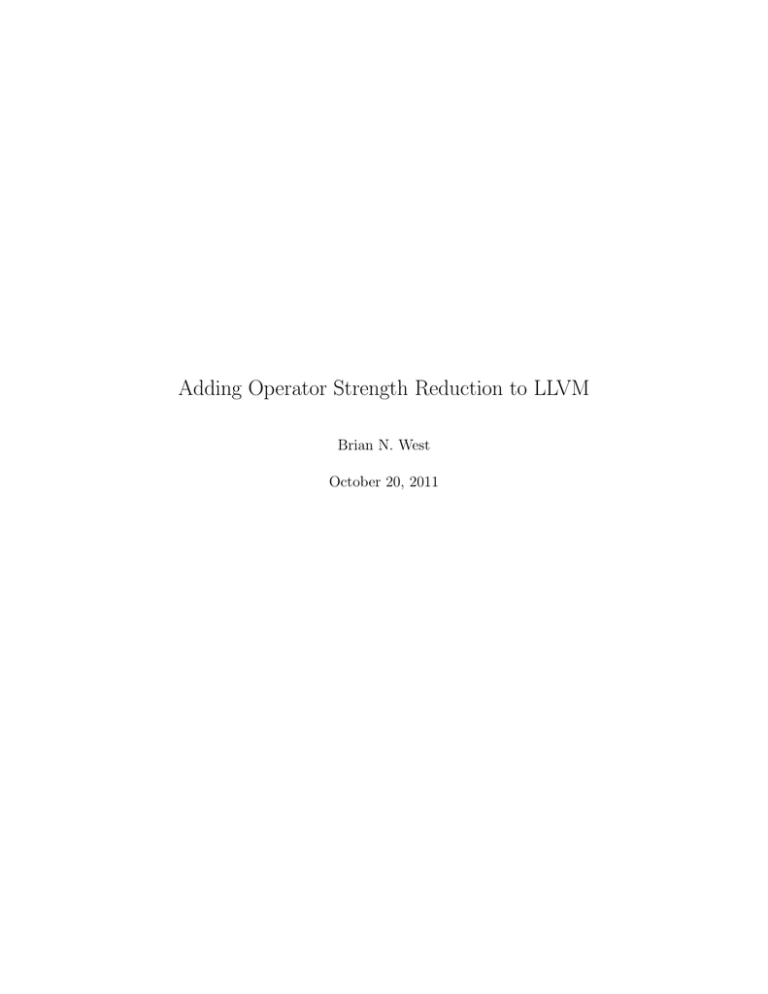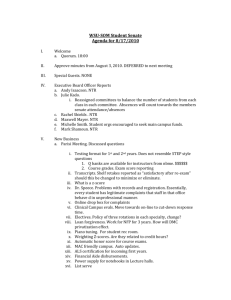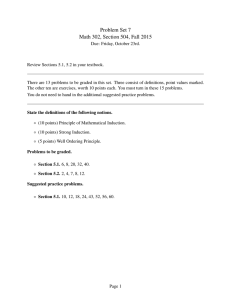Adding Operator Strength Reduction to LLVM Brian N. West October 20, 2011
advertisement

Adding Operator Strength Reduction to LLVM
Brian N. West
October 20, 2011
Chapter 1
Introduction
As part of the Platform-Aware Compilation Environment (PACE) Project1 , Operator Strength Reduction
(OSR) [3] was added to the LLVM Compiler Infrastructure Project (LLVM) as a optimization pass.
The goal of the PACE Project is to construct a portable compiler that produces code capable of achieving
high levels of performance on new architectures. The multi-tiered architecture of the PACE compiler included
high level and low level compilation components. LLVM was the choice for the low level optimizer and code
generator.
The high-level components of the PACE compiler include a Polyhedral-based optimization pass. This
optimization pass produces many opportunities for strength reduction. LLVM lacked a strength-reduction
optimization pass2 , so this is the motivation for adding the OSR optimization to LLVM.
1 This work is funded by the Defense Advanced Research Projects Agency through AFRL Contract FA8650-09-C-7915. The
opinions and findings in this document do not necessarily reflect the views of either the United States Government or Rice
University.
2 LLVM advertises a strength reduction optimization, which is actually part of the code generation pass in its backend and
not the stand alone optimization that PACE needed.
1
Chapter 2
Operator Strength Reduction
Operator strength reduction is a well known compiler optimization dating back to the very first production
compilers [2]. The basic idea is that instructions that require many cycles to execute are replaced by those
that require fewer cycles to complete. This optimization can be seen in the address calculation instructions
for an array within a loop. The following C code sums the array elements within a loop:
float sum, A[N];
sum = 0.0;
for (i=0; i<N; i++) {
sum += A[i];
}
Lowered to explicitly expose the address calculations, the code becomes:
float sum, A[N];
char *a_addr = &A;
char *a_i_address;
sum = 0.0;
i = 0;
while ( i < N ) {
int offset = sizeof(float) * i;
a_i_address = a_addr + offset;
sum = sum + *((float *)a_i_address);
}
The address calculation of A[i] has a multiplication instruction that for many architectures requires
multiple cycles, whereas an addition usually completes in a single cycle. The strength-reduction optimization
replaces the above multiplication with an add instruction. After strength reduction, the code becomes:
float sum, A[N];
int offset;
char *a_i_address = &A;
sum = 0.0;
i = 0;
while ( i < N ) {
sum = sum + *((float *)a_i_address);
a_i_address += sizeof(float);
i++;
}
The code introduced a new variable, a i address, which is a pointer into the A array and is incremented
each loop iteration by the size of the array element.
2
The loop variable i after strength reduction is only needed for the end of loop test. An additional
optimization, Linear Function Test Replacement (LFTR), can be performed to replace the loop test with a
test using the variable that strength reduction added. After LFTR, the variable i then becomes useless and
can be deleted.
3
Chapter 3
The OSR Algorithm
The OSR optimization of Cooper et al. [3] was developed as a replacement for the traditional strengthreduction optimization as described by Allen et al. [1], which was both hard to understand and hard to
implement.
OSR as outlined in the paper is performed on the intermediate representation of the program in Static
Single Assignment [4] (SSA) form. LLVM uses the SSA form exclusively for its optimization passes. Thus,
OSR was a good fit for PACE and LLVM.
OSR discovers induction variables in the program by finding loops in the SSA graph. The SSA Graph
contains nodes that map to the definitions and uses of values and contains edges that connect the definitions
to the uses. To be more precise, the loops are Strongly Connected Components (SCCs).
From the example code in Chapter 2, the associated SSA form is roughly:
float sum, A[N];
char *a_addr = &A;
char *a_i_address;
sum0 = 0.0;
i0 = 0;
while ( true ) {
sum0 1 = phi(sum0 , sum2 )
i1 = phi(i0 , i2 )
int offset = sizeof(float) * i1 ;
char *a_i_address = a_addr + offset;
sum2 = sum1 + *((float *)a_i_address);
i2 = i1 + 1;
}
Both variables i and sum have SCCs in the SSA graph. For example, variable i’s SCC contains the
definitions of i1 and i2 . The definition of i1 uses i2 and the definition of i2 uses i1 . Figure 3.1 displays the
SCC in the SSA graph for the induction variable i.
Of these two variables, OSR will recognize variable i as an induction variable, since i changes in a
uniform manner across each loop iteration, while sum does not. OSR uses the induction variables that
it finds to create new induction variables. In this example, OSR finds the expression, sizeof (f loat) ∗ i1 ,
to be a candidate for strength reduction. A new induction variable will be created that is incremented
by sizeof (f loat) (compile time constant). All uses of sizeof (f loat) ∗ i1 will replaced by uses of the new
induction variable. The new induction variable will also have its own SCC in the SSA graph, which can be
used to create additional induction variables.
4
0 i0
?
?
φ i1
1
*
? φ i2
Figure 3.1: SSA Graph for Induction Variable i
5
Chapter 4
Strength Reduction on 64-bit
Architectures
OSR was originally developed on a 32-bit architecture. Then, the most common integer size (e.g., C int) and
address size were both the same size, 32-bits. OSR for LLVM has been developed for a 64-bit architecture,
where the most common integer size is 32-bits and the address size is 64-bits. This size difference between
common integer and address types displayed latent strength-reduction problems1 .
The crux of the problem is that the 32-bit integer (or smaller) induction variables can overflow. If
OSR creates a 64-bit-address induction variable from a 32-bit-integer induction variable, an overflow in the
32-bit-integer arithmetic will not trigger similar behavior in the 64-bit-address arithmetic.
Some example code to display the overflow issue is:
int i;
unsigned char j;
float sum, A[256];
j = 0;
sum = 0.0;
for (i=0; i<8000; i++) {
j += 3;
sum += A[j];
}
// on loop exit, j should equal (8000*3) % 256 or 192
Within the loop, j always has an 8-bit value between 0 and 256. Likewise all accesses to array A via
A[j] will be contained within A. The overflow behavior of j must be preserved while considering strength
reduction. Naively adding 3 to a pointer within A, as strength reduction is wont to do, would not overflow
on the 8-bit boundary, would access A outside of its limits, and thusly would not produce correct code.
Looking only at the overflow problems of j in the above code understates the problem. The real target
for OSR is the address calculation for A[j], which contains an implicit multiplication by 4 (if the size of
the float type is 32-bits or 4 bytes). OSR will want to replace the multiplication by 4 with a new induction
variable based on j which will get incremented by 4 each loop iteration. Adding by 4 gets to the 8-bit
overflow boundary 4 times faster. To maintain the overflow characteristics of j, the multiplication would
logically need to be:
offset = (j*4) % (256*4);
and the OSR-created induction variable would logically need to be:
offset2 = (offset1 +4) % (256*4);
1 The
problem (with 8-bit integers) was first seen in LLVM’s test suite, within file: simple types constant folding.cpp.
6
4.1
Workarounds
An easy solution to this problem is to restrict strength reduction to those values of the same bit width. In
this case, OSR would only strength reduce 64-bit integers (e.g., C type long), matching the address size.
This decision might limit the number of opportunities, since legacy C code may have more 32-bit integers
than 64-bit integers.
An alternative may be to force 32-bit integer (e.g., C type int) variables to use 64-bit integers. This
might unfortunately break legacy code, if said code contains any strict assumptions regarding the size of
integer types.
7
Chapter 5
Strength Reduction for ANSI C
ANSI C specifies overflow behavior for its signed and unsigned integer types. For unsigned integers, overflow
is required to wrap. For signed integers, overflow is undefined, and the C compiler is free to handle the
overflow as it sees fit. A rationale for this divergent behavior is that some embedded architectures need to
support saturation instead of wrapping on integer overflow.
The existing strength-reduction optimization in LLVM’s backend exploits the ANSI C overflow rule when
handling signed 32-bit integers. Since the 32-bit signed integer overflow is undefined, LLVM makes a strong
assumption that the overflow cannot happen and that the program is always defined. Since overflow cannot
happen, signed 32-bit integer induction variables are used to create 64-bit address induction variables. LLVM
does not handle signed 16 and 8-bit integers similarly.
8
Chapter 6
OSR for LLVM
The OSR paper gave pseudo code for the procedures: OSR, ProcessSCC, DFS, ClassifyIV, RegionConst, Replace, Reduce, and Apply. The implementation follows the pseudo code.
6.1
Pseudo-Code Infelicities
Due to the nature of pseudo code, some details are missing or implicit, while other times there is a divergence
between the pseudo code and what it needs to be. Two cases of the latter were found during implementation.
In procedure ClassifyIV, the input SCC is filtered to see if it qualifies as an induction variable. The
first test is to see if the operator qualifies and the second is to see if the operands qualify. The ClassifyIV
pseudo-code in question is:
for each n ∈ SCC
if n.op ∈
/ {φ, +, -, COPY}
SCC is not an induction variable
else
for each o ∈ {operands of n}
if o ∈
/ SCC and not RegionConstant(o, header)
SCC is not an induction variable
The operator and operand tests in combination are imprecise. For example, the expression:
iv + iv
would pass the filter when it should not. A more precise filter would use the induction variable formula,
as it seen elsewhere in the pseudo code, like:
iv ± rc or rc + iv
Thus, the modified ClassifyIV pseudo-code is:
for each n ∈ SCC
if n.op is φ or COPY
if all operands are not members of the SCC and are not a region constant
SCC is not an induction variable
else if n.op is + or if n is not of the form x ← iv ± rc or x ← iv - rc
SCC is not an induction variable
else
SCC is not an induction variable
9
In procedure Reduce, the input SCC is cloned with a slight modification to create a new induction
variable. While looking at each operand for a cloned instruction, a test is made to see if the operand
definition is part of the SCC, so that Reduce can be recursively called using the operand. The test checks
to see if the SCC and operand are both induction variables with the same loop header. This test is not
precise enough. Not only should the operand and SCC share the same header, but they must also share the
same phi node in that header. Our implementation created another operand attribute, sccphi, to allow this
more precise test. The sccphi attribute was also needed for LFTR.
The original Reduce pseudo-code:
if o.header = v.header
Replace o with Reduce(opcode, o, rc)
needs to be replace with:
if o.header = v.header and o.sccphi = v.sccphi
Replace o with Reduce(opcode, o, rc)
6.2
Address Calculation in the LLVM IR
The address calculations in the OSR paper are explicit. The address calculations in the LLVM IR are not.
For example, an explicit address calculation into a floating point array, A[i], looks like:
&A + (i * 4)
In LLVM IR, the same calculation looks like:
getelementptr float* %A, i64 i
The multiplication by 4 (which is the size of a float) and the addition operator are not present in the
LLVM IR getelementptr instruction, which actually resembles explicit address calculations in ANSI C:
(A + i) /* aka A[i] */
The LLVM IR getelementptr instruction is a higher-level abstraction than what is presented in the OSR
paper. Mapping the OSR paper IR instruction to the getelementptr instruction is not always straightforward. Given a loop that descends, the induction variable update may look like:
i2 = i1 - stride;
The getelementptr instruction performs an implicit add between its operands. To map to getelementptr, the second operand needs to be negated before it can be added, e.g.,
tmp1 = sub i64 0, %stride
tmp2 = getelementptr float* %A, i64 %tmp1
10
Chapter 7
LFTR for LLVM
After OSR has completed for a function, Linear Function Test Replacement (LFTR) is run. LFTR examines
each induction variable (IV) that existed before OSR was run, to see if it is a candidate for replacement.
The primary condition for LFTR candidacy is when the only use of the pre-existing IV outside of its SCC
is an end-of-loop compare.
OSR records which newly created IV is derived from which other IV. The derived relationship is stored
in a derivation tree. The roots of the derivation tree are the pre-existing IVs. Each node of the derived tree
saves its associated IV and the transformation needed to get from its parent to itself.
If a LFTR candidate was found, the end-of-loop test is replaced with a new test using an OSR created
IV. The OSR IV is selected from one of the leaf nodes of the IV derivation tree. The series of transformation
needed to get from the root to the leaf are applied to the existing end-of-loop test. Next the old test in the
end-of-loop branch is replaced with a newly created test, leaving the SCC of the pre-existing IV useless and
deletable.
Recall that the OSR motivating example from Chapter 1 after strength reduction is:
float sum, A[N];
int offset;
char *a_i_address = &A;
sum = 0.0;
i = 0;
while ( i < N ) {
sum = sum + *((float *)a_i_address);
a_i_address += sizeof(float);
i++;
}
LFTR will find that pre-existing IV i is a candidate. The derivation tree with IV i as the root will contain
one leaf node for IV a i address. LFTR will create a new end-of-loop test using a i address and with it
replace the existing test. LFTR will then delete all occurrences of IV i. The example then becomes:
float sum, A[N];
int offset;
char *a_i_address = &A;
sum = 0.0;
while ( a_i_address < &A[N] ) {
sum = sum + *((float *)a_i_address);
a_i_address += sizeof(float);
}
The OSR paper describes a LFTR algorithm but gives no pseudo code. What the paper describes and
what is implemented are similar. A LFTR algorithm can also be found here [5].
11
Chapter 8
OSR Limitations
We have observed several limitations with OSR. Some of the limitations could possibly be addressed by
using a cost function to be more selective in creating induction variables. How to add a cost function to the
current OSR algorithm is an open question.
8.1
Speculation
OSR converts everything that matches its criteria, which may lead to creating induction variables that in
turn do not participate in an address calculation. For example, given an induction variable i, we could see
the following SSA code:
i0 =
loop_header:
i1 =
= i1
i2 =
0
phi(i0 , i2 )
+ 3
i1 + 1
OSR will want to create a new induction variable from the expression (i+3) which will look like:
i0 = 0
iplus30 = 0
loop_header:
i1 = phi(i0 , i2 )
iplus31 = phi(iplus30 , iplus32 )
= iplus31
i2 = i1 + 1
iplus32 = iplus31 + 1
In the loop, one addition (i1 +3) gets replaced by another (iplus31 +1); thus, there was no strength
reduction performed. OSR performs this transformation speculatively in hopes that an address calculation
like A[i+3] will be reached and reduced.
Note also from the above example that the newly created induction variable iplus31 has a lifetime that
spans the entire loop instead of potentially being limited to just at the definition and use. Increasing the
lifetime increases the register pressure in the loop, which complicates register allocation.
8.2
Pessimize Input Code Shape
The input code may be more optimal before OSR is performed, as compared to afterwords. Consider a
simple loop body:
12
A[i] = B[i] + C[i];
Unrolling this loop body by a factor of four will yield the new loop body:
A[i]
A[i+1]
A[i+2]
A[i+3]
=
=
=
=
B[i]
B[i+1]
B[i+3]
B[i+3]
+
+
+
+
C[i];
C[i+1];
C[i+2];
C[i+3];
OSR for the original loop will create three induction variable for &A[i], &B[i], and &C[i]. OSR for the
unrolled loop will create three induction variables for expressions (i+1), (i+2), and (i+3) and will create
twelve induction variables for the addressing of the A, B, and C arrays. This is arguably not the right
thing to do. Having fifteen induction variables live across a single loop could lead to spilling during register
allocation.
A similar argument could be made for the stencil calculation found in some high performance codes, like
the five stencil pattern:
A[i][j] = (
A[i-1][j] +
A[i][j-1] + A[ i ][j] + A[i][j+1] +
A[i+1][j]) / 5;
A reassociation optimization pass, in both the loop unrolling and the stencil examples, may change
the code shape and reduce the number of multiplications via anchoring array referencing around &A[i] or
&A[i][j]. In the loop unrolling example, the reassociation optimization pass may calculate &A[i+1] by
adding a constant to &A[i] versus calculating i+1, multiplying by the cell size and then adding the address
of A to the multiplication product. In this case, OSR has no multiplication to reduce, but will still create a
new induction variable for the expression, &A[i] plus a constant. Arguably, the reassociation optimization
pass produced near optimal code for the expression&A[i+1], which does not need to be strength reduced.
8.3
May Not Reduce Strength
Multiplying by a power of two can be replaced by a shift operator, which should cost the same as the add
with which OSR would want to replace it. This is a case where multiplication will not be expensive. This
case turns out to be common, since the sizes of intrinsic numerical types tend to be powers of two. Thus,
single-dimension numeric arrays likely do not need their strength reduced.
8.4
Move Code Into a Loop
Sometimes OSR creates an induction variable nested deeper than the targeted instruction that it replaces.
The following code displays this infelicity:
float sum = 0.0, A[N];
for (unsigned long i = 0; i < n; i++) {
sum += A[i];
}
return A[i-3];
OSR will recognize the expression A[i-3] as a candidate for strength reduction. OSR will create a new
induction variable for A[i-3] based on the i induction variable within the loop that precedes the expression
A[i-3]. Thus, the multiplication that is removed is replaced by an addition, which can be executed multiple
times in the preceding loop.
OSR will transform the above code to be:
13
float sum = 0.0, A[N];
for (unsigned long i = 0, char *a_i_minus_three_address = &A[-3];
i < n;
i++, a_i_minus_three_address += sizeof(float)) {
sum += A[i];
}
return *((float *)a_i_minus_three_address);
14
Chapter 9
Conclusions
Our implementation of OSR in LLVM follows the algorithm of Cooper et al. [3]. Inherent shortcomings
introduced into the transformed code suggest that this optimization should only be used in a system that
provides feedback to the compiler so that unprofitable transforms can be discarded.
15
Bibliography
[1] F E Allen, John Cocke, and Ken Kennedy. Reduction of operator strength. In Steven S Muchnick
and Neil D Jones, editors, Program Flow Analysis: Theory and Applications, chapter 3, pages 79–101.
Prentice-Hall, 1981.
[2] J. W. Backus, R. J. Beeber, S. Best, R. Goldberg, L. M. Haibt, H. L. Herrick, R. A. Nelson, D. Sayre,
P. B. Sheridan, H. Stern, I. Ziller, R. A. Hughes, and R. Nutt. The fortran automatic coding system.
In Papers presented at the February 26-28, 1957, western joint computer conference: Techniques for
reliability, IRE-AIEE-ACM ’57 (Western), pages 188–198, New York, NY, USA, 1957. ACM.
[3] Keith D. Cooper, L. Taylor Simpson, and Christopher A. Vick. Operator strength reduction. ACM
Trans. Program. Lang. Syst., 23:603–625, September 2001.
[4] Ron Cytron, Jeanne Ferrante, Barry K. Rosen, Mark N. Wegman, and F. Kenneth Zadeck. Efficiently
computing static single assignment form and the control dependence graph. ACM Trans. Program. Lang.
Syst., 13:451–490, October 1991.
[5] Linda Torczon and Keith Cooper. Engineering A Compiler. Morgan Kaufmann Publishers Inc., San
Francisco, CA, USA, 2004.
16






